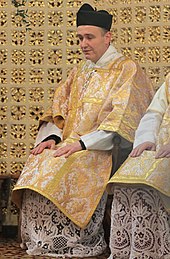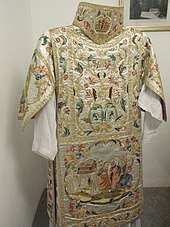Dalmatic


The dalmatic is a long, wide-sleeved
Like the chasuble worn by priests and bishops, it is an outer vestment and is supposed to match the
History
In the
It was a normal item of clothing at the time when ecclesiastical clothes began to develop separately around the fourth century, worn over a longer tunic by the upper classes, and as the longest part of the dress of men of lower rank.
The dalmatic was a garment of
Roman Church

The dalmatic is a robe with wide sleeves; it reaches to at least the knees or lower. In 18th-century vestment fashion, it is customary to slit the under side of the sleeves so that the dalmatic becomes a mantle like a
In the Roman Catholic Church the
Traditionally the dalmatic was not used in the Roman Rite by deacons during Lent. In its place, depending on the point in the liturgy, was worn either a folded chasuble or what was called a broad stole, which represented a rolled-up chasuble. This tradition went back to a time at which the dalmatic was still considered an essential secular garment and thus not appropriate to be worn during the penitential season of Lent.
-
Dalmatic Roman usage (with its closed sleeves)
-
Baroque dalmatic (with slit, flap-like sleeves common for dalmatics worn outside Italy)
-
Capa pluvial (cope) and ornately embroidered dalmatic pairs (late 1800s, early 1900s, Our Lady of Manaoag museum, Philippines)
Eastern tradition

In the Byzantine Rite the sakkos, which is elaborately decorated and amply cut, usually worn by the bishops as an outer vestment in place of a presbyter's phelonion and which, like the phelonion, corresponds to the western chasuble and cope, is derived from Byzantine imperial dress, and hence is identical in origin to the Western dalmatic.
In all Eastern rites the sticharion (which is analogous to the Western alb), of the ornate sort worn by deacons and lower clergy, is sometimes referred to as a dalmatic.
References
External links
- History of the Dalmatic in the Catholic Church
- Phillips, Walter Alison (1911). . Encyclopædia Britannica. Vol. 7 (11th ed.). pp. 776–777.
![]() This article incorporates text from a publication now in the public domain: Braun, Joseph (1908). "Dalmatic". Catholic Encyclopedia. Vol. 4.
This article incorporates text from a publication now in the public domain: Braun, Joseph (1908). "Dalmatic". Catholic Encyclopedia. Vol. 4.



